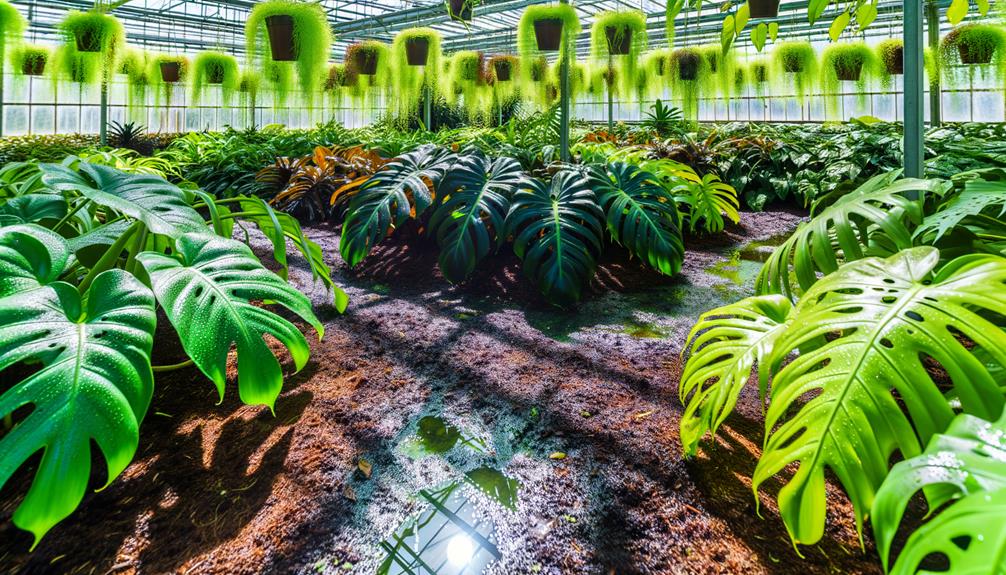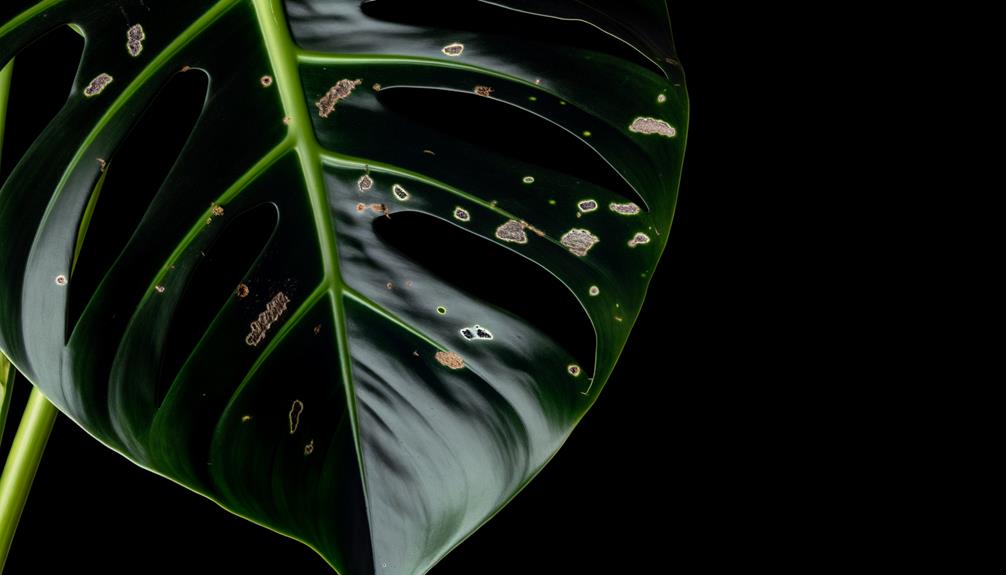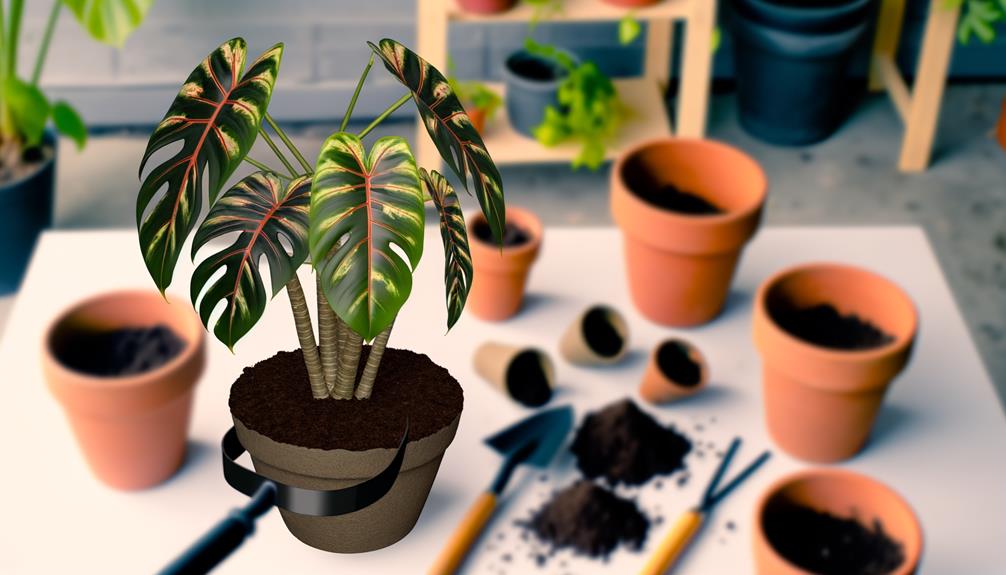Albo Dark Black Monstera Deliciosa
You're intrigued by the Albo Dark Black Monstera Deliciosa, a unique variant originating from Central American rainforests. It's known for its deep green foliage adorned with irregular white patches due to a genetic mutation.
Care for it by providing high humidity (60-80%), indirect light, and well-draining soil composed of perlite, orchid bark, and peat moss. Water when the top inch of soil dries out and fertilize monthly with a balanced, water-soluble fertilizer.
Proper pruning using sterilized tools ensures healthy growth. This species' intricate needs and features make it a captivating plant to cultivate.
Discover more intricate aspects of its care and propagation.

Key Takeaways
- Albo Dark Black Monstera Deliciosa features deep green leaves with unique white variegation due to a genetic mutation.
- Originating from Central American rainforests, it thrives in high humidity and indirect light conditions.
- It requires a soil mix of perlite, orchid bark, and peat moss for proper aeration and drainage.
- Fertilize monthly with a balanced, water-soluble fertilizer and maintain humidity levels between 60-80%.
- Prune regularly using sterilized shears to remove dead leaves and promote new growth.
Origin and History

The Albo Dark Black Monstera Deliciosa, a striking variegation of the Monstera deliciosa, traces its origins to the tropical rainforests of Central America, where its unique genetic mutation emerged.
You'll find this cultivar belonging to the Araceae family, thriving under the dense canopy of these forests. The plant's history involves a naturally occurring mutation, which led to its distinctive dark variegation.
Botanists and horticulturists discovered this rare specimen while exploring the rich biodiversity of regions like Guatemala and Costa Rica. Over time, enthusiasts propagated it selectively, ensuring its survival outside its native habitat.
Understanding its origins helps you appreciate the intricate ecological factors that contributed to the development of this remarkable plant.
Unique Features
You'll notice the Albo Dark Black Monstera Deliciosa boasts striking variegation with its deep green foliage interspersed with irregular white patches.
Its growth requires specific care, including high humidity and indirect light, to maintain its variegated leaves.
Understanding Monstera deliciosa's needs, such as its aerial roots and climbing nature, guarantees excellent health and growth.
Striking Leaf Variegation
Characterized by dramatic splashes of creamy white and deep green on its large, fenestrated leaves, the Albo Dark Black Monstera Deliciosa showcases a striking leaf variegation that distinguishes it from other cultivars. This unique variegation occurs due to a genetic mutation affecting chlorophyll distribution, resulting in a visually fascinating mosaic pattern.
Understanding these features helps you appreciate the Albo Dark Black Monstera Deliciosa's botanical beauty.
- Irregular marbling: The mix of white and green pigments creates an unpredictable and unique pattern on each leaf.
- Fenestrations: The characteristic split and hole patterns in the leaves enhance the visual contrast between the variegated sections.
- Glossy texture: The leaves' shiny surface accentuates the vibrant color differences, making the variegation even more pronounced.
Growth and Care Tips
To secure your Albo Dark Black Monstera Deliciosa thrives, prioritize well-draining soil, consistent humidity, and indirect sunlight. Use a soil mix containing perlite, orchid bark, and peat moss to secure adequate aeration and drainage.
Maintain humidity levels between 60-80% using a humidifier or pebble tray. Position the plant in bright, indirect light to prevent leaf scorch while promoting chlorophyll production.
Water when the top inch of soil feels dry, and secure the pot has drainage holes to avoid waterlogging. Fertilize monthly during the growing season with a balanced, water-soluble fertilizer at half strength.
Regularly wipe leaves with a damp cloth to remove dust and enhance photosynthesis. Prune dead or yellow leaves to encourage new growth.
Ideal Growing Conditions

To cultivate your Albo Dark Black Monstera deliciosa successfully, you should focus on providing ideal light conditions, precise watering schedules, and specific soil preferences.
Make sure it receives bright, indirect light to mimic its natural habitat. Water the plant when the top inch of soil feels dry, and use a well-draining, organic-rich substrate to promote healthy root development.
Light Requirements
For ideal growth, the Albo Dark Black Monstera deliciosa requires bright, indirect light, simulating the dappled sunlight of its native tropical rainforest understory. Position your plant near a north-facing window or use sheer curtains to diffuse direct sunlight. Too much direct light can scorch the leaves, while insufficient light hampers variegation and growth.
Filtered sunlight through tree canopies: Mimicking its natural habitat.
Soft, ambient lighting: Ensuring even light distribution.
Avoidance of harsh midday sun: Preventing leaf burn and stress.
Incorporate full-spectrum grow lights if natural light is inadequate, ideally providing 12-14 hours of light daily. Remember, maintaining consistent light conditions is essential for the Monstera deliciosa 'Albo Dark Black' to thrive and develop its striking foliage.
Watering Schedule
Maintaining a precise watering schedule is crucial for the health of your Monstera deliciosa 'Albo Dark Black,' making sure that the soil remains consistently moist but never waterlogged. Check the soil's moisture content regularly using a hygrometer or by inserting your finger about an inch deep.
During the growing season, typically from spring to early autumn, water your Monstera when the top inch of soil feels dry. Reduce watering frequency in winter, allowing the soil to dry out slightly more between waterings.
Utilize lukewarm, filtered water to avoid chlorine and fluoride buildup, which can harm the plant. Ensure your pot has drainage holes to prevent root rot (Rhizoctonia solani) and keep ideal humidity levels around 60-70% for best growth.
Soil Preferences
Ideal soil preferences for Monstera deliciosa 'Albo Dark Black' include a well-draining, nutrient-rich mix composed of peat moss, perlite, and orchid bark, ensuring both aeration and moisture retention. This combination provides the perfect balance for root health, preventing root rot while allowing for sufficient water absorption. You should aim for a slightly acidic pH level, around 5.5 to 6.5, which optimizes nutrient uptake.
Peat moss: Offers organic material that holds moisture without becoming waterlogged.
Perlite: Enhances drainage and prevents soil compaction, promoting root oxygenation.
Orchid bark: Adds large particles to the mix, further improving aeration and mimicking the plant's natural epiphytic environment.
Light Requirements
To flourish, the Albo Dark Black Monstera Deliciosa needs bright, indirect light to maintain its vibrant variegation and overall health. Direct sunlight can scorch its leaves, causing chlorophyll breakdown and reducing the plant's aesthetic appeal. Place your Monstera Deliciosa 'Albo Variegata' in a location where it receives filtered light, such as near an east-facing window.
Insufficient light may result in etiolation, where the plant stretches towards the light source, leading to elongated, weak stems and smaller leaves. For best photosynthesis, ensure the light intensity is around 10,000 to 20,000 lux.
Artificial grow lights, such as full-spectrum LED lights, can supplement natural light, providing the necessary wavelength range for robust growth and maintaining the plant's striking variegated patterns.
Watering Schedule

In addition to ideal lighting, Albo Dark Black Monstera Deliciosa requires a carefully monitored watering schedule to thrive. You should water it when the top inch of soil feels dry. Overwatering can lead to root rot, so make sure the pot has drainage holes.
Keep an eye on the plant's specific needs:
- Humidity levels: Maintain a relative humidity of around 60-70% to mimic its natural tropical environment.
- Water quality: Use filtered or distilled water to prevent mineral buildup and leaf burn.
- Watering frequency: Adjust based on seasonal changes; water more frequently in summer and reduce in winter.
Monitor these factors closely, and you'll provide best hydration for your Albo Dark Black Monstera Deliciosa.
Soil Preferences
For ideal growth, Albo Dark Black Monstera Deliciosa thrives in a well-draining soil mix with a blend of peat moss, perlite, and orchid bark.
Peat moss (Sphagnum spp.) provides aeration and retains moisture, ensuring the roots don't stay waterlogged.
Perlite, a volcanic glass, enhances drainage and prevents soil compaction, promoting robust root development.
Orchid bark, typically derived from fir (Abies spp.), offers coarse texture, allowing air circulation around the roots.
This combination mimics the plant's natural epiphytic environment, optimizing its nutrient uptake and overall health.
Avoid using heavy garden soil, as it can lead to poor aeration and root rot.
Regularly check for soil moisture to maintain the ideal growing conditions for your Monstera deliciosa 'Albo Variegata'.
Fertilization Tips

To maximize the growth of your Albo Dark Black Monstera Deliciosa, focus on ideal nutrient ratios, particularly nitrogen (N), phosphorus (P), and potassium (K).
Implement a seasonal feeding schedule, increasing fertilization during the growing months and reducing it in the dormant period.
Avoid common mistakes like over-fertilizing, which can lead to root burn and nutrient imbalances.
Optimal Nutrient Ratios
Achieving the perfect nutrient ratios for your Albo Dark Black Monstera deliciosa requires a balanced blend of macronutrients like nitrogen (N), phosphorus (P), and potassium (K) in a 3:1:2 ratio. Fostering this precise combination promotes ideal growth and vibrant foliage.
Nitrogen supports luxuriant, verdant leaves, phosphorus aids in root development and flowering, while potassium enhances overall plant health and disease resistance.
To visualize the impact, consider:
- Luxuriant, deep green leaves: High nitrogen content promotes vigorous leaf growth.
- Strong root system: Sufficient phosphorus encourages robust root networks.
- Improved resilience: Potassium fortifies cellular function and stress tolerance.
Seasonal Feeding Schedule
Maintaining the ideal nutrient ratios is just the start; implementing a seasonal feeding schedule guarantees your Albo Dark Black Monstera deliciosa receives the right nutrients at the best times for robust growth throughout the year. Focus on the plant's active growth periods. During spring and summer, use a balanced, water-soluble fertilizer like 20-20-20, applied bi-weekly. Reduce feeding to once a month in fall and winter, switching to a fertilizer with lower nitrogen content to prevent overgrowth.
| Season | Fertilizer Type | Frequency |
|---|---|---|
| Spring | 20-20-20 | Bi-weekly |
| Summer | 20-20-20 | Bi-weekly |
| Fall | Low-Nitrogen (e.g., 5-10-10) | Monthly |
| Winter | Low-Nitrogen (e.g., 5-10-10) | Monthly |
Adjust as necessary based on your plant's specific growth conditions.
Common Fertilizer Mistakes
Over-fertilizing your Albo Dark Black Monstera deliciosa can lead to nutrient burn, characterized by yellowing leaves and browned edges. The key is to understand the plant's specific needs and avoid common mistakes.
First, don't apply fertilizer too frequently; it can cause salt buildup in the soil, leading to root damage.
Second, avoid using a high-nitrogen formula, as it can result in rapid, weak growth that's prone to pests.
Ultimately, never fertilize a dry plant; always water first to prevent root shock.
- Salt Buildup: White crust on soil surface.
- Weak Growth: Spindly stems, susceptible to pests.
- Root Shock: Wilted appearance after fertilization.
Pruning and Maintenance
Pruning your Albo Dark Black Monstera deliciosa involves carefully removing dead or damaged leaves and stems to promote healthy growth and maintain its striking appearance. Use sterilized pruning shears to avoid introducing pathogens. Cut just above a leaf node to encourage new growth. Regular pruning helps manage the plant's size and shape, while also increasing air circulation, reducing the risk of fungal infections.
| Task | Tools Needed | Frequency |
|---|---|---|
| Remove dead leaves | Sterilized pruning shears | As needed |
| Trim damaged stems | Sterilized pruning shears | Monthly |
| Shape the plant | Sterilized pruning shears | Bi-monthly |
Common Pests and Diseases

At times, your Albo Dark Black Monstera deliciosa might attract common pests like spider mites (Tetranychidae) and mealybugs (Pseudococcidae), which can lead to significant health issues if not promptly addressed.
Spider mites, often found on the undersides of leaves, form fine webbing and cause stippling damage, leading to chlorosis.
Mealybugs, covered in a white waxy coating, cluster at leaf nodes and excrete honeydew, promoting sooty mold growth.
Regular monitoring and prompt intervention are vital to maintaining your plant's health and vigor.
- Spider Mites (Tetranychidae): Fine webbing, stippling damage, chlorosis.
- Mealybugs (Pseudococcidae): White waxy coating, honeydew secretion, sooty mold.
- Root Rot (Rhizoctonia solani): Brown, mushy roots, foul odor, wilting foliage.
Propagation Methods
Preserving the health of your Albo Dark Black Monstera deliciosa through careful pest control guarantees a sturdy plant that's prepared for propagation via methods such as stem cuttings and air layering.
For stem cuttings, select a healthy node with aerial roots. Use sterilized pruning shears to cut below the node, then place the cutting in water or a well-draining potting mix. Maintain consistent moisture and indirect light for root development.
Air layering involves injuring a stem and wrapping it with moist sphagnum moss, securing it with plastic wrap. Over weeks, roots will form within the moss. Once established, sever the rooted section below the new roots and plant it independently.
Both techniques enhance genetic consistency and vigor in propagated Monstera deliciosa.
Potting and Repotting

When potting and repotting your Albo Dark Black Monstera deliciosa, make certain you select a container with drainage holes and use a well-aerated, organic-rich potting mix to support its robust root system. Monstera deliciosa thrives in a substrate that mimics its natural epiphytic environment.
Guarantee your mix contains components such as:
- Bark chips: These provide excellent aeration and mimic the tree bark Monstera naturally climbs.
- Perlite: Enhances drainage and prevents root rot by allowing excess water to escape.
- Coco coir: Retains moisture while maintaining a light, airy structure, promoting healthy root growth.
Repotting should be done every 1-2 years, ideally in spring, to accommodate growth and refresh the soil, preventing nutrient depletion and root bound issues.
Display Ideas
Displaying your Albo Dark Black Monstera deliciosa can transform any space into a lush, tropical haven, especially when you utilize vertical structures and hanging planters to showcase its climbing and trailing nature. Incorporate moss poles or trellises to encourage Monstera deliciosa's aerial roots (radices aeriae) to anchor and climb. Opt for hanging planters to allow the fenestrated leaves to cascade beautifully. Utilize shelves to create a tiered display, maximizing visual impact while providing adequate light exposure. For a cohesive look, match planter materials with your interior design.
| Display Method | Description |
|---|---|
| Moss Poles | Supports aerial roots, enhances vertical growth |
| Trellises | Guides climbing habit, adds structure |
| Hanging Planters | Showcases trailing leaves, saves floor space |
| Shelves | Creates tiered display, maximizes light exposure |
| Matching Planters | Ensures a cohesive design, complements interior aesthetics |
Conclusion
Nurturing an Albo Dark Black Monstera deliciosa is a rewarding journey. By understanding its origins, unique variegation, and ideal growing conditions, you can guarantee your plant thrives.
Remember, best light and a precise watering schedule prevent any 'unwanted guests' (pests and diseases). Master propagation techniques, and your Monstera will flourish, becoming the centerpiece of your botanical collection.
With care and attention, you'll witness this Araceae family's marvel transform your space into a verdant sanctuary.






